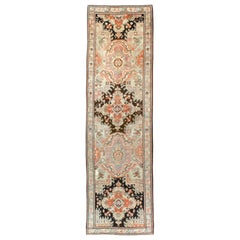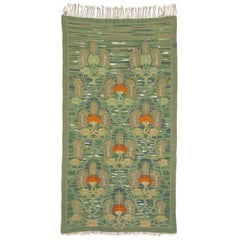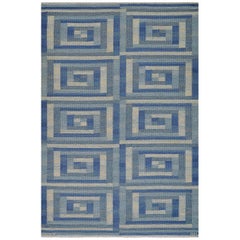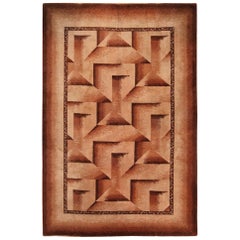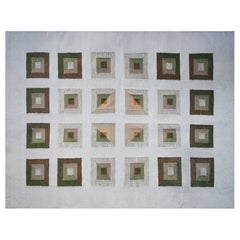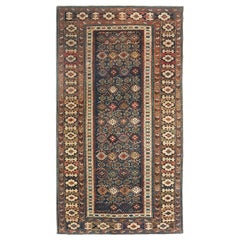Early 20th Century Russian and Scandinavian Rugs
to
65
Width
to
Length
to
438
36
11
11
9
3
2
2
1
1
8
236
2,177
1,722
438
1,378
141
205
21
61
38
55
126
179
69
5
4
436
430
189
4
3
409
29
438
438
438
212
112
106
104
82
9
4
2
2
2
Period: Early 20th Century
Antique Russian Karabagh Runner
Located in New York, NY
An antique Russian Karabagh rug from the first quarter of the 20th century featuring tones of coral, browns and light purple.
Category
Russian Tribal Vintage Early 20th Century Russian and Scandinavian Rugs
Materials
Wool
Norwegian Wall Hanging, 1920
Located in New York, NY
Norwegian wall hanging
Norway, circa 1920.
Possibly designed by Frida Hansen.
Polychrome composition with floral motif.
Category
Norwegian Vintage Early 20th Century Russian and Scandinavian Rugs
Materials
Wool
$28,000
Early 20th Century Marta Maas-fjetterström Ab Swedish Rug by Barbro Nilsson
Located in West Hollywood, CA
This vintage handwoven Swedish rug has a tonal blue field with overall design of linked shaded color bands forming whimsical concentric paneled matrix. This is an exceptional example...
Category
Swedish Mid-Century Modern Early 20th Century Russian and Scandinavian Rugs
Materials
Wool
Antique Art Deco Design English Wilton Rug. 8 ft 10 in x 13 ft 5 in
Located in New York, NY
Beautifully artistic antique English Art Deco design Wilton rug, country of origin / rug type: Antique English rug, date circa 1920's. Size: 8 ft 10 in x 13...
Category
English Art Deco Early 20th Century Russian and Scandinavian Rugs
Materials
Wool
Scandinavian Art Deco – Exceptional Art Rug 236 X 174 Cm – No. 1567
Located in Paris, FR
Scandinavian Art Deco – Exceptional Art Rug 236 x 174 cm – No. 1567 Timeless elegance and graphic lines meet in this exceptional rug, combining the rigor of Art Deco style with the w...
Category
Scandinavian Scandinavian Modern Vintage Early 20th Century Russian and Scandinavian Rugs
Materials
Wool
Antique Russian Chichi, circa 1900s
Located in WEST HOLLYWOOD, CA
Rug Number
17218
Size
3' 5" X 6' 2"
Design
Chichi
Collection
Antique/Vintage
Material
Wool
Texture
Pile Weave
Origin
Russia
Age
Antique/Vintage.
Category
Russian Antique Early 20th Century Russian and Scandinavian Rugs
Materials
Wool
1900s Antique Uzbek Khotan Samarkand Rug-5'8'' X 4'1''
Located in Los Angeles, US
Up for sale is a 1900s Antique Uzbek Khotan Samarkand Rug 5'8'' x 4'1'', tribal and traditional, wool on cotton
Category
Uzbek Tribal Antique Early 20th Century Russian and Scandinavian Rugs
Materials
Wool, Cotton
Early 20th Century Marta Maas-fjetterström Ab Swedish Rug by Barbro Nilsson
Located in West Hollywood, CA
This traditional handwoven Swedish flat-weave has an overall field of blue, grey and beige striae with alternating rows of waving diagonal lozenges, in an unusual playful striped bor...
Category
Swedish Mid-Century Modern Early 20th Century Russian and Scandinavian Rugs
Materials
Wool
Early 20th Century, Swedish Pile Rug
Located in New York, NY
Early 20th century, Swedish Pile rug
Sweden, circa 1920-1930s
handwoven.
Category
Swedish Early 20th Century Russian and Scandinavian Rugs
Materials
Wool
Zabihi Collection Floral Karabagh Rug
Located in New York, NY
a mid-20th-century floral Karabagh Accent size Rug
Details
rug no. j4302
size 4' 1" x 7' 3" (124 x 221 cm)
Category
Russian Bessarabian Early 20th Century Russian and Scandinavian Rugs
Materials
Wool
Antique Caucasian Kazak Runner. 3 ft 5 in x 12 ft 3 in
Located in New York, NY
Antique Caucasian Tribal long and narrow Kazak runner, origin: The Caucasus, woven circa 1900. Size: 3 ft 5 in x 12 ft 3 in (1.04 m x 3.73 m).
Category
Caucasian Kazak Early 20th Century Russian and Scandinavian Rugs
Materials
Wool
Antique Russian Kazak Rug with Black and Beige Scarab Medallions
Located in Dallas, TX
Antique Russian rug handwoven from the finest sheep’s wool and colored with all-natural vegetable dyes that are safe for humans and pets. It’s a traditional Kazak design featuring Sc...
Category
Persian Oushak Vintage Early 20th Century Russian and Scandinavian Rugs
Materials
Wool
$5,040 Sale Price
20% Off
Antique Early-20th Century Bessarabian Rug
Located in New York, NY
Antique Bessarabian rug, circa 1900
FJ Hakimian #02590.
Category
Bessarabian Early 20th Century Russian and Scandinavian Rugs
Materials
Wool
Black Ground Antique Ukrainian Cotton Rug with 18th Century Revivalist Pattern
Located in Milan, IT
Ukrainian and Bessarabian carpets are typically flat-woven, as this was a tradition imported in the early 18th century from France by Peter the Great, who is said to have opened vari...
Category
Ukrainian Bessarabian Early 20th Century Russian and Scandinavian Rugs
Materials
Cotton
Vintage Hand-Knotted Wool Whimsical Swedish Rug
Located in West Hollywood, CA
This traditional hand-woven Swedish rug has an ivory field with dense geometric sprays in checkered paneled spandrels, enclosed by a whimsical indigo alternating icon border between ...
Category
Swedish Art Deco Early 20th Century Russian and Scandinavian Rugs
Materials
Wool
Early 20th Century Caucasian Kazak Throw Rug
Located in New York, NY
An antique Caucasian Kazak throw rug. The red field is divided by a subtle trellis with geometric palmettes and leaves in a manner original to Kuba rugs from the northeast Caucasus. ...
Category
Scandinavian Kazak Early 20th Century Russian and Scandinavian Rugs
Materials
Wool
Doris Leslie Blau Early 20th Century Russian Bessarabian Handmade Rug
Located in New York, NY
Early 20th century Russian Bessarabian floral handmade wool rug
Size: 7'10" × 9'2" (238 × 279 cm)
This early 20th-century Russian Bessarabian flat-weave rug, circa 1900, is a remarka...
Category
Russian Bessarabian Early 20th Century Russian and Scandinavian Rugs
Materials
Wool
Antique Soumak Rug 7'10'' x 9'10''
Located in New York, NY
Soumak (also spelled Soumakh, Sumak, Sumac, or Soumac) is a tapestry technique of weaving strong and decorative textiles used as rugs and domestic bags. Baks used for bedding are kno...
Category
Russian Sumak Early 20th Century Russian and Scandinavian Rugs
Materials
Wool
Antique Caucasian Kazak by Mehraban Rugs
Located in WEST HOLLYWOOD, CA
Our traditional Caucasian Kazak rug is inspired by tribal patterns. Neutral color schemes are well-complemented with the panel all-over design. This rug is a deal for flooring or wal...
Category
Turkish Antique Early 20th Century Russian and Scandinavian Rugs
Materials
Wool
1900 Antique Khotan Samarkand Rug- 8'10'' X 5'3''
Located in Los Angeles, US
Ca.1900 Antique Khotan Samarkand Rug 8'10'' X 5'3''
Category
Asian Tribal Antique Early 20th Century Russian and Scandinavian Rugs
Materials
Wool, Cotton
Antique Silk Chinese Motifs Textile, ca. 1900
Located in Ferrara, IT
This is a small antique silk Chinese textile woven during the beginning of the 20th century circa 1900 and measures 50 x 47CM in size. Its design is centered around a man that is hol...
Category
Chinese Other Early 20th Century Russian and Scandinavian Rugs
Materials
Silk
1920s Antique Needlepoint Rug - 6'7'' X 6'5''
Located in Los Angeles, US
Needlepoint rugs were created using the traditional needlework weaving technique that is used to make everyday items from furniture to carpets and artwork. However, it has a fascinating history both as a hobby and as an industry. When many people think of carpets, they think of pile carpets or flat weave kilims, but needlepoint has also been used to create beautiful carpets. These carpets are durable and an important part of carpet history.
Archaeologists and scholars consider the roots of needlepoint to have been around 1500 BC. They consider the first needlepoint to include the fine diagonal stitches that were used to sew tents together by the ancient Egyptians. The art eventually evolved into tapestry weaving. However, a tapestry weaving differs significantly from needlepoint in that it uses a loom and vertical warp.
Tapestry weaving is closer to the weaving of kilims and pile rugs than canvas work. However, some still include tapestry weaving in the category of needlepoint because of the fine work that appeared during the late Renaissance. It can have a similar appearance to the untrained eye. Technically, tapestry weaving and needlepoint are not the same, and they do not use the same technique.
The first actual needlepoint rugs and needle-points began to appear in the late Renaissance. Needlepoint is worked by creating stitches on a stiff canvas. The canvas is typically made from jute or linen and is quite durable. Pieces from the Renaissance were used to cover footstools, chairs, pillows, bed headboards, and other furnishings. They were also used as table coverings and wall coverings. You could also find them on many small items such as purses, shoes, and various adornments for clothing.
During the Renaissance, the craft reached a high level of skill, and the designs became incredibly detailed and realistic. They mimicked many of the subjects and styles of famous paintings of the time. They created florals, still life designs, scenes, and geometric tiled pieces. Some of them mimicked the designs found in Persian Carpets.
Needlepoint reached its peak popularity in the 19th century when it was considered a proper occupation for a lady. Needlepoint and embroidery held a similar place in societal status at the time. During this time, the work became finer, with some of the canvas reaching a high level of detail. The level of detail is determined by counting the number of mesh in an inch. During this time petit point by French needlewomen could have a mesh count as high as 45 mesh. This allowed women to create highly intricate designs with incredible levels of detail.
It is possible to find many antique pieces of needlepoint besides rugs. Needlepoint rugs were popular in France and Spain, where the technique was adapted to create highly intricate designs that mimicked the designs in architecture and fashion. They were popular because they were durable, and it could be fashioned into a variety of items. The canvases themselves were durable, and the wool that they used was also strong, which means that many of the pieces were able to withstand daily use. We have many artifacts that have survived from this time period.
Needlepoint rugs are important collectibles because they are different from the pile rugs and kilims that are typically found on the market. Needlepoint carpets are special because they take many hours to create, especially larger works. Needlepoint pieces of any type became popular throughout Europe during the 19th century. It is still a popular hobby today, but perhaps one of the most interesting stories is that of the Portuguese needlewomen of Arraiolos.
The story of these women and their beautiful carpets begins in 1492. Needlepoint was a popular occupation in Spain, which had a large population of Moors and Jews. They were an integral part of Spanish culture. However, in 1492, Queen Isabella of Spain issued a proclamation that gave these ethnic groups the order to pack their bags and board ships headed...
Category
Other Vintage Early 20th Century Russian and Scandinavian Rugs
Materials
Wool
Early 20th Century Swedish Flat-Weave Carpet
Located in New York, NY
Early 20th century Swedish flat-weave carpet.
Category
Swedish Early 20th Century Russian and Scandinavian Rugs
1900 Antique Animal Design Bessarabian Flat Weave Rug
Located in Los Angeles, US
Antique Bessarabian Rugs / Kilims in both pile and tapestry weaving technique are some of the more beautiful carpets to have been produced in Europe. Many of the Bessarabian Kilims w...
Category
Other Antique Early 20th Century Russian and Scandinavian Rugs
Materials
Wool, Cotton
Rug Designed by Emma Salzman, Finland, Early 1900s
By Emma Salzman
Located in Stockholm, SE
Rug designed by Emma Salzman,
Finland, early 1900's.
Rya technique. Handwoven wool.
Measurements:
H: 349 cm/ 11' 5 7/16"
W. 185 cm/ 6 26/32"
Category
Finnish Scandinavian Modern Antique Early 20th Century Russian and Scandinavian Rugs
Materials
Wool
Antique Fine Persian Baluch Rug
Located in Los Angeles, US
Baluch Rugs – Antique Baluch rugs are a unique phenomenon in the world of antique Oriental rugs. Rather than originating from one specific, easily identified region, Baluch rugs are ...
Category
Asian Tribal Vintage Early 20th Century Russian and Scandinavian Rugs
Materials
Wool
Zabihi Collection Mini Size Persian Pictorial Rug
Located in New York, NY
An early 20th century Persian pictorial rug from the city of Isfahan
Measures: 1'7'' x 1'10''.
Category
Persian Islamic Early 20th Century Russian and Scandinavian Rugs
Materials
Wool
1900s Antique French Needlepoint Rug
Located in Los Angeles, US
Needlepoint rugs were created using the traditional needlework weaving technique that is used to make everyday items from furniture to carpets and artwork. However, it has a fascinating history both as a hobby and as an industry. When many people think of carpets, they think of pile carpets or flat weave kilims, but needlepoint has also been used to create beautiful carpets. These carpets are durable and an important part of carpet history.
Archaeologists and scholars consider the roots of needlepoint to have been around 1500 BC. They consider the first needlepoint to include the fine diagonal stitches that were used to sew tents together by the ancient Egyptians. The art eventually evolved into tapestry weaving. However, a tapestry weaving differs significantly from needlepoint in that it uses a loom and vertical warp.
Tapestry weaving is closer to the weaving of kilims and pile rugs than canvas work. However, some still include tapestry weaving in the category of needlepoint because of the fine work that appeared during the late Renaissance. It can have a similar appearance to the untrained eye. Technically, tapestry weaving and needlepoint are not the same, and they do not use the same technique.
The first actual needlepoint rugs and needle-points began to appear in the late Renaissance. Needlepoint is worked by creating stitches on a stiff canvas. The canvas is typically made from jute or linen and is quite durable. Pieces from the Renaissance were used to cover footstools, chairs, pillows, bed headboards, and other furnishings. They were also used as table coverings and wall coverings. You could also find them on many small items such as purses, shoes, and various adornments for clothing.
During the Renaissance, the craft reached a high level of skill, and the designs became incredibly detailed and realistic. They mimicked many of the subjects and styles of famous paintings of the time. They created florals, still life designs, scenes, and geometric tiled pieces. Some of them mimicked the designs found in Persian Carpets.
Needlepoint reached its peak popularity in the 19th century when it was considered a proper occupation for a lady. Needlepoint and embroidery held a similar place in societal status at the time. During this time, the work became finer, with some of the canvas reaching a high level of detail. The level of detail is determined by counting the number of mesh in an inch. During this time petit point by French needlewomen could have a mesh count as high as 45 mesh. This allowed women to create highly intricate designs with incredible levels of detail.
It is possible to find many antique pieces of needlepoint besides rugs. Needlepoint rugs were popular in France and Spain, where the technique was adapted to create highly intricate designs that mimicked the designs in architecture and fashion. They were popular because they were durable, and it could be fashioned into a variety of items. The canvases themselves were durable, and the wool that they used was also strong, which means that many of the pieces were able to withstand daily use. We have many artifacts that have survived from this time period.
Needlepoint rugs are important collectibles because they are different from the pile rugs and kilims that are typically found on the market. Needlepoint carpets are special because they take many hours to create, especially larger works. Needlepoint pieces of any type became popular throughout Europe during the 19th century. It is still a popular hobby today, but perhaps one of the most interesting stories is that of the Portuguese needlewomen of Arraiolos.
The story of these women and their beautiful carpets begins in 1492. Needlepoint was a popular occupation in Spain, which had a large population of Moors and Jews. They were an integral part of Spanish culture. However, in 1492, Queen Isabella of Spain issued a proclamation that gave these ethnic groups the order to pack their bags and board ships headed...
Category
Other Antique Early 20th Century Russian and Scandinavian Rugs
Materials
Wool, Cotton
Bobyrug’s Wonderful Extra Large Santa Claus Design French Algerian Rug
Located in Saint Ouen, FR
Beautiful long European style Algerian rug with nice colors and patterns very decorative with a curious design showing Santa Claus on each detail design, a...
Category
Algerian Scandinavian Modern Early 20th Century Russian and Scandinavian Rugs
Materials
Wool, Cotton
$19,170 Sale Price
20% Off
Antique Khotan Samarkand Rug-7'5'' X 4'5''
Located in Los Angeles, US
Up for sale is an antique Samakhand Uzbek rug, circa the 1900s.
Category
Uzbek Tribal Antique Early 20th Century Russian and Scandinavian Rugs
Materials
Wool, Cotton
Early 20th Century Antique Kilim Bessarabian Rug 9'5'' X 5'5''
Located in Los Angeles, US
Antique Bessarabian Rugs / Kilims in both pile and tapestry weaving technique are some of the more beautiful carpets to have been produced in Europe. Many of the Bessarabian Kilims were woven around the mid to late 19th century, though some do date back to the 18th century as well. This production that carried into the early twentieth century under late Ottoman Turkish rule in an area corresponding to modern Bulgaria and Romania, they stand right on the cusp of European and Oriental carpet weaving. Many of the designs are floral patterns made in a naturalistic western style utilizing brown or black ground, not unlike certain Karabaghs from the Caucauses. But others, particularly flat weaves, reflect the tradition of Turkish kilims from nearby Anatolia, although in a distinctive Bessarbian palette. In either case they are supremely decorative rugs.
History Of Antique Flat Woven Bessarabian Kilim Rugs from Romania
Bessarabian Kilims and carpets are flat woven rugs that originate in the Russian provinces of the Ukraine and Moldova in the late 1800’s to the early 1900’s. While most carpet experts will classify the flat woven rugs as Bessarabian they will often refer to the knotted pile carpets as Ukrainian.
The Bessarabian carpets differ from antique Persian carpets in many ways. For example, unlike Persian carpets, Bessarabian rugs cannot be classified to a region according to the way the rugs were woven. Their weaves provide indications regarding the area for which they were created rather than for their classification. The markets these antique rugs were designed for could have fallen into different categories such as a rural market or an urban one. But all other attributes were dismissed and all the Romani made area rugs and carpets are referred to as Bessarabian instead.
Antique Romanian Bessarabian kilims are ornate and they come in a variety of designs as well color combinations. It’s not uncommon for some Bessarabian kilims to be more floral while others may feature more geometric patterns. Bessarabian carpets are made on carpet weaving looms similar to the ones used to make the French Aubusson rugs.
These looms are wooden, and the rugs are flat woven / kilims. The best of these rug types were created in the 1700’s. The Russian Imperial Tapestry Factory was where these Romanian rugs were made, and the factory was created by none other than Peter the Great. He established the Russian Imperial Tapestry Factory following his return from England and France. He was inspired to create the factory after being in awe of the splendid Aubusson carpets, Savonnerie rugs, and Axminster carpets he saw while abroad.
The beautiful carpets he admired while in Europe had already caught the eyes of his Russian contemporaries, and importing them was triggering a financial drain for the Russian treasury. For this reason, the Russian Imperial Tapestry Factory was used as a location for copying the French and English carpets Peter the Great and the Russian nobility desired.
Demand for these lavishly luxurious rugs grew, and additional factories were created in villages. This region is from where these rugs got the name Bessarabian. The region is divided between two territories: the Republic of Moldova and Romania. Bessarabian rug weavers were country people who had a country taste. Though they were tasked with replicating the elaborate motifs of the European rugs, they added their own unique country’s flair to their borrowed rug patterns and designs. This more folksy or traditional approach to the European patterns...
Category
Neoclassical Antique Early 20th Century Russian and Scandinavian Rugs
Materials
Wool
Märta Måås-Fjetterström Early 20th- century Swedish Pile Rug
Located in Los Angeles, CA
Created by Swedish textile designer Märta Måås-Fjetterström in the early to mid 20th century, this traditional wool hand-woven Swedish pile rug has features a rich brown base with mu...
Category
Swedish Scandinavian Modern Early 20th Century Russian and Scandinavian Rugs
Materials
Wool
Vintage Swedish Scandinavian Flossa Rug, 05'09 x 07'11
Located in Dallas, TX
79050 Vintage Swedish Scandinavian Flossa Rug, 05'09 x 07'11. This captivating vintage Swedish Flossa rug from the 1930's is a remarkable example of...
Category
Swedish Scandinavian Modern Early 20th Century Russian and Scandinavian Rugs
Materials
Wool
$5,040 Sale Price
20% Off
Antique Chinese Rug with Floral Design
Located in Los Angeles, US
Antique Chinese Rugs, as opposed to most of the antique rug productions, were woven almost exclusively for internal consumption. Since they were mostly sheltered from European and We...
Category
Asian Other Antique Early 20th Century Russian and Scandinavian Rugs
Materials
Wool, Cotton
Antique Needlework Floral Rug
Located in Los Angeles, US
Needlepoint rugs were created using the traditional needlework weaving technique that is used to make everyday items from furniture to carpets and artwork. However, it has a fascinat...
Category
Asian Other Antique Early 20th Century Russian and Scandinavian Rugs
Materials
Wool, Cotton
Vintage Swedish Rya Rug Doris Leslie Blau
Located in New York, NY
Vintage Swedish Rya Rug Doris Leslie Blau
Size: 10'0" × 14'10" (304 × 452 cm)
This exceptional vintage Swedish Rya rug, signed "K.S. 1929," is a true testament to the rich Scandinavi...
Category
Scandinavian Mid-Century Modern Early 20th Century Russian and Scandinavian Rugs
Materials
Wool
1900s Antique Animal Samarkand Rug
Located in Los Angeles, US
Antique Samarkand Rugs: The desert oasis of Khotan was an important stop on the Silk Road. The people of Khotan were expert carpet weavers who produced high quality antique rugs and ...
Category
Asian Tribal Antique Early 20th Century Russian and Scandinavian Rugs
Materials
Wool, Cotton
1920s Antique Needlepoint Runner
Located in Los Angeles, US
The technique for creating needlepoint rugs and other objects made from needlepoint has remained unchanged since its beginnings in the 17th century. It all begins with a canvas with ...
Category
Other Vintage Early 20th Century Russian and Scandinavian Rugs
Materials
Wool
Antique Caucasian Rose Karabagh Karabakh Carpet with Traditional Style
By Mario Buatta
Located in Dallas, TX
79207 Antique Caucasian Karabagh Kilim Rug Runner, 03'01 x 10'00. Like a woven bouquet from the mountains of the southern Caucasus, this handwoven wool antique Karabagh kilim runner ...
Category
Russian Aesthetic Movement Early 20th Century Russian and Scandinavian Rugs
Materials
Wool
Early 20th Century Caucasian Kazak Accent Rug
Located in New York, NY
An antique Caucasian Kazak accent rug handmade during the Early 20th century.
Measures: 3' 8" x 6' 8"
Category
Scandinavian Kazak Early 20th Century Russian and Scandinavian Rugs
Materials
Wool
1920s Antique Botanical Flat Weave Bessarabian Rug
Located in Los Angeles, US
Antique Bessarabian Rugs / Kilims in both pile and tapestry weaving technique are some of the more beautiful carpets to have been produced in Europe. Many of the Bessarabian Kilims w...
Category
Other Early 20th Century Russian and Scandinavian Rugs
Materials
Wool, Cotton
Antique Turkish Silk Rug
Located in Los Angeles, US
Turkish rugs (also referred to as Anatolian rugs) are, arguably, the rugs that started it all. These carpets were among the first wave of Oriental antique carpets to be exported into Europe. The vintage Turkish rugs were prized commodities and artistically influential pieces. The designs of Turkish rugs such as the iconic guls, prayer rugs and small repeating patterns found on these carpets, worked their way into the iconic paintings of the European masters, including Memling, Lotto, Bellini, Hans Holbein and many others.
These painters were inspired so much by Turkish rugs and the design motifs they feature that the artists have lent their names to some of these famous Turkish patterns. One of the most famous artists that incorporated rugs from Turkey in his painting was the great and iconic 16th century painter Hans Holbein.
The styles of Turkish rugs...
Category
Asian Other Antique Early 20th Century Russian and Scandinavian Rugs
Materials
Wool, Cotton
$25,500
1900s Antique Fine Indian Purple Amritsar Rug
Located in Los Angeles, US
Antique Amritsar Rugs – The spectacular rugs of Amritsar capture the exotic style of India while incorporating a subtle colonial influence. This convergence of eastern and western st...
Category
Asian Other Antique Early 20th Century Russian and Scandinavian Rugs
Materials
Wool, Cotton
Antique Needlework Floral Design
Located in Los Angeles, US
Needlepoint rugs were created using the traditional needlework weaving technique that is used to make everyday items from furniture to carpets and artwork. However, it has a fascinat...
Category
Other Antique Early 20th Century Russian and Scandinavian Rugs
Materials
Wool, Cotton
19th Century Authentic Khotan Samarkand Rug
Located in Los Angeles, US
Antique Samarkand Rugs: The desert oasis of Khotan was an important stop on the Silk Road. The people of Khotan were expert carpet weavers who produced high quality antique rugs and ...
Category
Empire Antique Early 20th Century Russian and Scandinavian Rugs
Materials
Wool, Cotton
Early 20th Century Antique British Needlework Rug
Located in Los Angeles, US
Needlepoint rugs were created using the traditional needlework weaving technique that is used to make everyday items from furniture to carpets and artwork. However, it has a fascinat...
Category
Other Early 20th Century Russian and Scandinavian Rugs
Materials
Wool, Cotton
Plush Vintage Karabagh Rug
Located in New York, NY
Plush pile Karabagh rug with an all-over Herati and floral design on a salmon colored field and a floral border in soft brown/ some accents in light blue sparkled in the field and bo...
Category
Russian Bessarabian Early 20th Century Russian and Scandinavian Rugs
Materials
Wool, Angora
$5,500 Sale Price
20% Off
1920s Antique Needlepoint Runner
Located in Los Angeles, US
Needlepoint rugs were created using the traditional needlework weaving technique that is used to make everyday items from furniture to carpets and artwork. However, it has a fascinat...
Category
Other Vintage Early 20th Century Russian and Scandinavian Rugs
Materials
Wool, Cotton
1920s Vintage Flat Weave Decorative Soumak Rug
Located in Los Angeles, US
oumak rugs (also spelled Sumak) – This construction technique produces a flat-weave rug that is thick, strong and exceptionally durable. Unlike kilims, Soumak rugs are not reversible...
Category
Tribal Vintage Early 20th Century Russian and Scandinavian Rugs
Materials
Wool
Antique 1920 Floral Samarkand Rug
Located in Los Angeles, US
Antique Samarkand Rugs: The desert oasis of Khotan was an important stop on the Silk Road. The people of Khotan were expert carpet weavers who produced high quality antique rugs and ...
Category
Other Vintage Early 20th Century Russian and Scandinavian Rugs
Materials
Wool, Cotton
Early 20th Century Antique Samarkand Rug
Located in Los Angeles, US
Antique Samarkand Rugs: The desert oasis of Khotan was an important stop on the Silk Road. The people of Khotan were expert carpet weavers who produced high quality antique rugs and ...
Category
Other Antique Early 20th Century Russian and Scandinavian Rugs
Materials
Wool, Cotton
19th Century Authentic Samarkand Rug
Located in Los Angeles, US
Antique Samarkand Rugs: The desert oasis of Khotan was an important stop on the Silk Road. The people of Khotan were expert carpet weavers who produced high quality antique rugs and ...
Category
Empire Antique Early 20th Century Russian and Scandinavian Rugs
Materials
Wool, Cotton
Antique Central Asian Khotan Samarkand Rug 7'3'' X 4'1''
Located in Los Angeles, US
Antique Central Asian Khotan Samarkand Rug 7'3'' x 4'1''
Category
Asian Other Antique Early 20th Century Russian and Scandinavian Rugs
Materials
Wool, Cotton
Mid-19th Century Persian Zanjan Rug 5.6x4.1
Located in Los Angeles, US
Antique Zanjan Rug 5.6x4.1, handmade and hand-knotted, wool on cotton foundation, tribal carpet, authentic Persian carpet, vegetable dyes, tribal carpet from mid-19th Century
Category
Other Antique Early 20th Century Russian and Scandinavian Rugs
Materials
Wool, Cotton
Early-19th Century Antique Chinese Small Rug - 5'10'' X 3'3''
Located in Los Angeles, US
Antique Chinese Rugs, as opposed to most of the antique rug productions, were woven almost exclusively for internal consumption. Since they were mostly sheltered from European and We...
Category
Asian Ming Antique Early 20th Century Russian and Scandinavian Rugs
Materials
Wool
Antique Khotan Samarkand Rug-7'5'' X 4'5''
Located in Los Angeles, US
Up for sale is an Antique Khotan Samarkand Rug, from Uzbekistan, circa the 1900s.
Category
Uzbek Tribal Antique Early 20th Century Russian and Scandinavian Rugs
Materials
Wool, Cotton
19th Century Antique Tribal Khotan Samarkand 8'9'' X 5'8''
Located in Los Angeles, US
Antique Samarkand Rugs: The desert oasis of Khotan was an important stop on the Silk Road. The people of Khotan were expert carpet weavers who produced high quality antique rugs and ...
Category
Asian Tribal Antique Early 20th Century Russian and Scandinavian Rugs
Materials
Wool, Cotton
Antique Khotan Samarkand Rug-8'0'' X 5'5''
Located in Los Angeles, US
Up for sale is a 1900s Antique Decorative Khotan Samarkand Rug
Category
Asian Tribal Antique Early 20th Century Russian and Scandinavian Rugs
Materials
Wool, Cotton
Zabihi Collection Geometric Karabagh Runner
Located in New York, NY
an early 20th century wide Geometric Karabagh Runner
Measures: 3'10'' x 8'4''.
Category
Russian Bessarabian Early 20th Century Russian and Scandinavian Rugs
Materials
Wool, Angora
Antique Handmade Samarkand Rug Ca.1900 - 8'7'' X 5'4''
Located in Los Angeles, US
Antique Samarkand Rugs: The desert oasis of Khotan was an important stop on the Silk Road. The people of Khotan were expert carpet weavers who produced high quality antique rugs and ...
Category
Asian Tribal Antique Early 20th Century Russian and Scandinavian Rugs
Materials
Wool, Cotton
Recently Viewed
View AllMore Ways To Browse
Antique Pedestal Fruit Bowl
Antique Pie Birds
Antique Primitive Blanket Chest
Antique Punch Tool
Antique Tang Dynasty Horse Sculpture
Antique Tea Leaf China
Antique Wall Pocket Vase
Antique Wall Pocket Vases
Antique Wedgwood China
Antique Wood And Glass Curio Cabinet
Antique Wood Oven
Antique Wood Putti Cherub
Antique Wooden Indian Cabinet
Arched Church Doors
Arne Wahl Iversen For Vinde Mobelfabrik
Art Deco Borzoi
Art Deco Burl Dining Chairs
Art Deco Porcelain Powder
